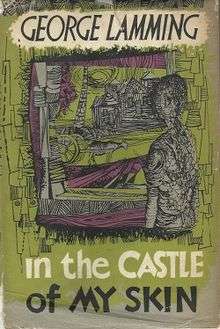In the Castle of My Skin
In the Castle of My Skin is the first and much acclaimed novel by Barbadian writer George Lamming, originally published in 1953 by Michael Joseph in London, and subsequently published in New York City by McGraw-Hill. The novel won a Somerset Maugham Award and was championed by eminent figures Jean-Paul Sartre and Richard Wright,[1] the latter writing an introduction to the book's US edition.[2] An autobiographical coming-of-age novel, set in the 1930s–'40s in Carrington Village, Barbados, where the author was born and raised,[3] In the Castle of My Skin follows the events in the life of a young boy named G, taking place against the background of dramatic changes in the society in which he lives.[4][5] The book's title comes from a couplet in Derek Walcott's early work Epitaph for the Young: XII Cantos (1949): "You in the castle of your skin / I the swineherd."[6][7]

Cover art by Denis Williams
Background
In the Castle of My Skin has been characterised by Sandra Pouchet Paquet as an "autobiographical novel of childhood and adolescence written against the anonymity and alienation from self and community the author experienced in London at the age of twenty-three."[8] Lamming himself has described the context in which the novel was written:
Migration was not a word I would have used to describe what I was doing when I sailed with other West Indians to England in 1950. We simply thought we were going to an England that had been painted in our childhood consciousness as a heritage and a place of welcome. It is the measure of our innocence that neither the claim of heritage nor the expectation of welcome would have been seriously doubted. England was not for us a country with classes and conflicts of interest like the islands we left. It was the name of a responsibility whose origin may have coincided with the beginning of time (...)
Much of the substance of my first novel, In the Castle of My Skin, is an evocation of this tragic innocence. Nor was there, at the time of writing, any conscious effort on my part to emphasise the dimension of cruelty that had seduced, or driven, black people into such lasting bonds of illusion. It was not a physical cruelty. Indeed, the colonial experience of my generation was almost wholly without violence. It was a terror of the mind; a daily exercise in self-mutilation. Black versus black in a battle for self-improvement.
This was the breeding ground for every uncertainty of self. (...)
The novel was completed within two years of my arrival in London. I still shared in that innocence that had socialised us into seeing our relations to empire as a commonwealth of mutual interests....[9]
Critical reception
In the Castle of My Skin has been widely praised and analysed since its first publication, receiving more critical attention than any of Lamming's other works.[10] Introducing the American edition, Richard Wright referred to "Lamming's quietly melodious prose",[11] while Ngũgĩ wa Thiong'o saw the book as "a study of colonial revolt" and "one of the great political novels in modern 'colonial' literature".[12]
References
- "George Lamming", East-West Center.
- George Lamming interview by Erika J. Waters, The Caribbean Writer, 7 December 1998.
- Thaichi, "Memoirs: In the Castle of My Skin by George Lamming". Bookish Relish, 19 July 2012.
- "In the Castle of My Skin" at Encyclopedia.com.
- Anderson, Teresa, "In the Castle of My Skin", Colonial & Postcolonial Literary Dialogues, Western Michigan University.
- Joyce E. Jonas, "Carnival Strategies in Lamming's In the Castle of My Skin", Callaloo, No. 35 (Spring, 1988), pp. 346–360.
- Sandra Pouchet Paquet, "Part 2: The Estranging Sea", in Caribbean Autobiography: Cultural Identity and Self-Representation, University of Wisconsin Press, 2002, p. 158.
- "Lamming, George", Postcolonial Studies @ Emory.
- George Lamming, "Sea of stories", The Guardian, 24 October 2002.
- "George Lamming: Critical reception", in Daryl Cumber Dance (ed.), Fifty Caribbean Writers: A Bio-bibliographical Critical Sourcebook, Greenwood Press, pp. 270–275.
- Richard Wright, Introduction to In the Castle of My Skin, New York: McGraw-Hill, 1953, pp. v–viii.
- Ngũgĩ wa Thiong'o, "George Lamming's In the Castle of My Skin", in Homecoming: Essays on African and Caribbean Literature, Culture and Politics, New York: Lawrence Hill, 1972, pp. 110–126.
External links
- "Lamming on 'In The Castle of My Skin'", 2013, National Cultural Foundation, Barbados. YouTube.